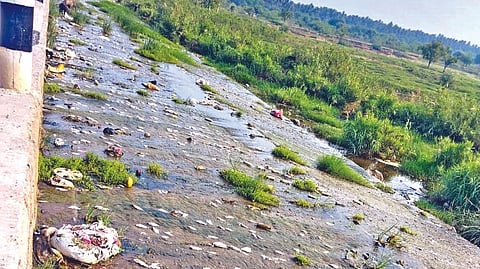

VELLORE: The mass death of fish in the Palar on Friday has caused health hazard concerns among villagers of Madanur in Tirupattur district and Ulli in the Vellore district.
The dead fish were sighted initially near the newly-built causeway across the Palar connecting Tirupattur and Vellore districts. The causeway, which was washed away in the previous floods, was reconstructed and the work left many deep pits and trenches. As a result, whenever there is flow in the Palar, water gets pooled up in these holes and locals at this point used to get fish in abundance. As a dam in neighbouring Andhra Pradesh has reached nearly full storage, the surplus is being let into Palar. Due to the discharge, there is flow and good availability of fish in the river. However, the mass death of fish has shocked the residents and environment enthusiasts.
The mass death has led to a tiff between conservationists and Tamil Nadu Pollution Control Board (TNPCB) over the cause and the impact. Ecologist G Srikanth who spoke to the DT Next said that the fish death started mounting on Friday. “Fingers are being pointed at the tanneries which allegedly let out untreated effluents into the river taking advantage of the flow. But TNPCB engineers disagree,” he said.
Vaniyambadi TNPCB engineer Gopalakrishnan ruled out the tannery effluent spin to the mass death, saying “the incident is a localised one. Other parts of the 20-km stretch between Madanur and Ambur had not reported any such incident.”
But TNPCB is yet to give a clear reason as the test results of samples sent to the Vellore PCB are awaited. “It could be due to poor levels of dissolved oxygen (DO), which should ideally be above 7 mg per litre for fish to survive. While tougher fish breeds survive even if the DO level drops below 3, they too can’t survive if the level dips below 2 mg/l,” said Gopalakrishnan.
The TNPCB official cites indiscriminate dumping of construction debris, unchecked growth of algae and excessive heat as possible reasons. “It is not a serious problem, but some might suffer minor issues like itching” he added.
Sources pointed out that livestock dependent on the stagnant water have not shown any scary symptoms so far. But wary locals await a clear announcement from the TNPCB.
Visit news.dtnext.in to explore our interactive epaper!
Download the DT Next app for more exciting features!
Click here for iOS
Click here for Android